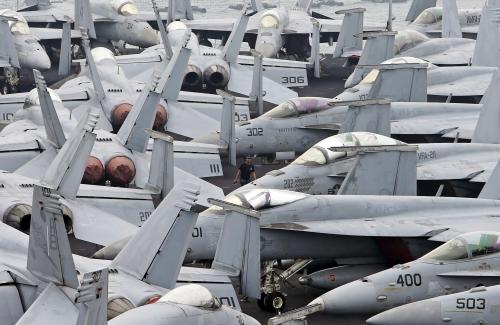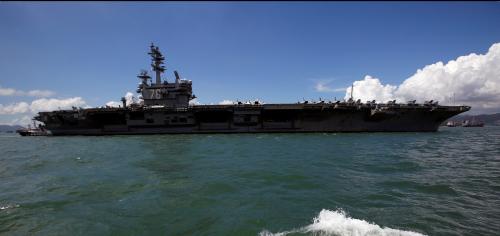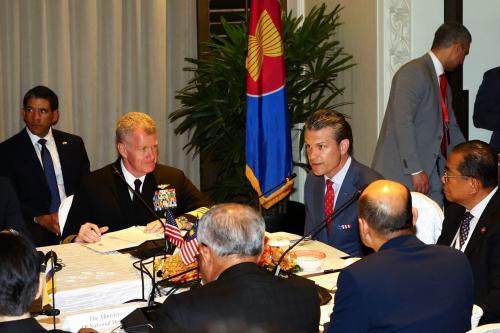On January 30, the House of Representatives passed a defense appropriations bill for the third time this year. The bill authorized $659.2 billion in non-discretionary defense spending for 2018.
That represents a solid commitment and would enable needed improvements in current military readiness. But there are two problems. First, it is February—the bill is already four months late. Second, the bill has zero chance of reaching the president’s desk, since Senate Democrats and Republicans—unable to reach a compromise on unrelated issues—are unlikely to pass their version of a defense appropriations bill any time soon. Once again, military funding is caught in a game of political tug of war on Capitol Hill. The impasse has already resulted in multiple Continuing Resolutions (CRs) and one government shutdown.
Sadly, these past four months are only the latest chapter in a decade of budget uncertainty. This uncertainty makes it nearly impossible for the Department of Defense to manage its highly complex programs efficiently. As the secretary of the Navy recently quipped: “[Since 2011,] we have put $4 billion in a trash can, poured lighter fluid on it, and burned it.” Put another way, congressional gridlock means the taxpayer pays more for worse military readiness.
Making an abstract problem concrete
No one willingly pays more for worse. The military is no different, but must rely on Congress to authorize spending on time. For the last 10 years, generals, admirals, and civilian experts have testified before Congress regarding the damage caused by CRs.
In simple terms, CRs prevent military planners from starting new programs and executing the fiscal plan they painstakingly design in advance. For the most part, under a CR, jets still fly, soldiers still train, and ships still go to sea—but many other programs sit idle. Some training is delayed. Acquisition programs and maintenance for equipment are especially hit hard. Specific examples include:
- During the most recent government shutdown, approximately 100,000 guardsmen and reservists where scheduled to drill. Because of the shutdown, that training was cancelled.
- Due to CR restrictions, the Navy cancelled maintenance for the USS Gunston Hall (LSD-44) in 2011. The ship eventually received all deferred maintenance, but at significantly increased cost. The scheduled maintenance period increased from 270 days to 696 days and costs increased from $44.7 million to $111 million.
- Due to the most recent rounds of CRs, the Navy delayed induction of 11 ships scheduled for shipyard maintenance this year. Maintenance delays for these ships will ultimately have impacts similar to the USS Gunston Hall.
As the commanding officer of a U.S. Navy helicopter squadron, CRs directly affected the readiness of my aircraft. Budgetary uncertainty hits the military supply chain hard. Under a CR, spare parts are often short. Contractors and suppliers cannot start new orders until a budget is signed. Eventually, part shortages hit the fleet. We are forced to “cannibalize” parts from one aircraft to make another one whole. A good widget is pulled off a down aircraft to fix another. This inefficient process doubles the amount of work and time required to conduct maintenance. This resulted in longer periods of downtime for my aircraft and reduced training opportunities for my aircrew.
I was not alone. In the F/A-18 squadrons of my air wing, entire aircraft were moved around from squadron to squadron to meet operational requirements. Squadrons that were not deploying were occasionally left with only a handful of ready jets to train with. Super Hornet inventory problems plague the entire Navy. Vice Admiral Shoemaker reported to Congress last October that only one-third of the Navy’s Super Hornets were ready to “fight tonight” and only half could fly at all. These aircraft shortages interrupt training cycles and add stress to already tight timelines. In order to get deploying squadrons out the door, we rob resources from the “bench.” This shell game of jets is inefficient, costs more over time, and results in worse readiness.
None of this is a secret. In what has become a sad, annual tradition, the secretary of defense lists these fiscal calamities in a letter to Congress every September. His predictions are slowly coming true once again in 2018.
What we need
What is to be done? First, the military can and should focus on the things it can control. In an organization as large as the Department of Defense, there are always opportunities to save money with little impact on combat readiness and capability. Overhead can be reduced and redundant headquarters staff eliminated. Secretary of Defense James Mattis lists this as a priority in his recent National Defense Strategy. Every dollar saved on overhead is another one available for current and future readiness.
Second, the military can adapt to the realities of this political environment. As Chief of Naval Operations Admiral John Richardson recently explained in a speech at the Heritage Foundation, the Navy has adjusted some ship maintenance funding to multi-year accounts to avoid the downfalls of a CR. The Navy also no longer schedules major work or acquisition milestones in the first quarter of the year. Admittedly, these are Band-Aid solutions for a much more serious injury. As Admiral Richardson said: “in competition that’s that close, you can’t expect a team to win if they only play three quarters out of four…That’s kind of what our fiscal environment is asking us to do in many ways.”
Third, the military must more actively and visibly communicate to Congress and the public. The Department of Defense and its allies in Congress must make the dangers of repeated Continuing Resolutions real to the American voter. During a speech at a recent conference of naval officers, Representative Mike Gallagher (R-WI) drove this point home:
Despite the old adage that ‘Loose Lips Sink Ships,’ non-existent strategic communications can sink entire navies…We need more than the usual talking points, generic warnings of risk and the same comms policy…Explain how the future fleet will fight; how it will be different from the Navy fleet of today, and how it will meet our security needs.
He added: “Whatever we’re doing right now isn’t working…I want my colleagues to get letters about Navy issues just like they do on other issues.”
On February 8, the most recent CR will expire. Unless a grand budget bargain between Senate Democrats and Republicans is struck soon, either the government will shut down again or they will pass yet another CR. Either way, military readiness will take another hit. We need a federal budget and we needed it four months ago.
Cmdr. Dan Keeler is the former commanding officer of a helicopter squadron and currently serves as a Federal Executive Fellow at the Brookings Institution. The views and opinions expressed are the author’s alone and do not represent the official position of the U.S. Navy, U.S. Department of Defense, or U.S. government.
The Brookings Institution is committed to quality, independence, and impact.
We are supported by a diverse array of funders. In line with our values and policies, each Brookings publication represents the sole views of its author(s).









Commentary
For the military’s sake, stop the budget delays
February 5, 2018